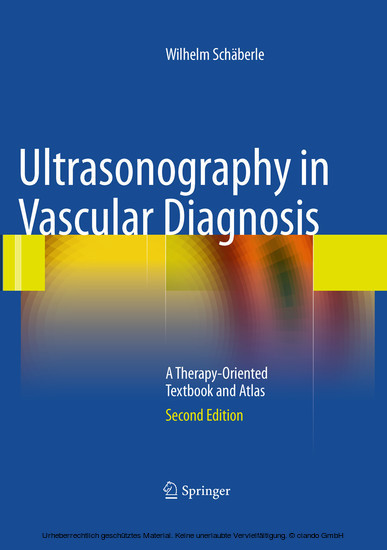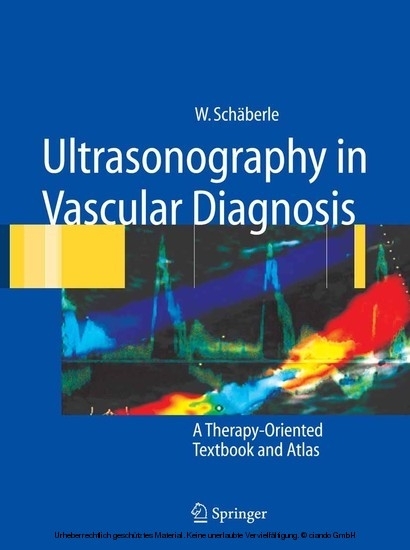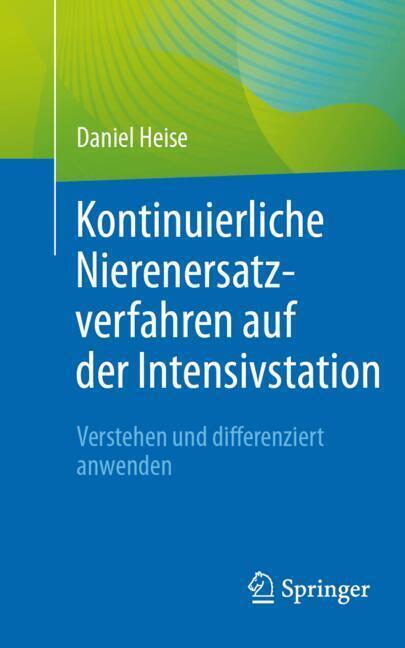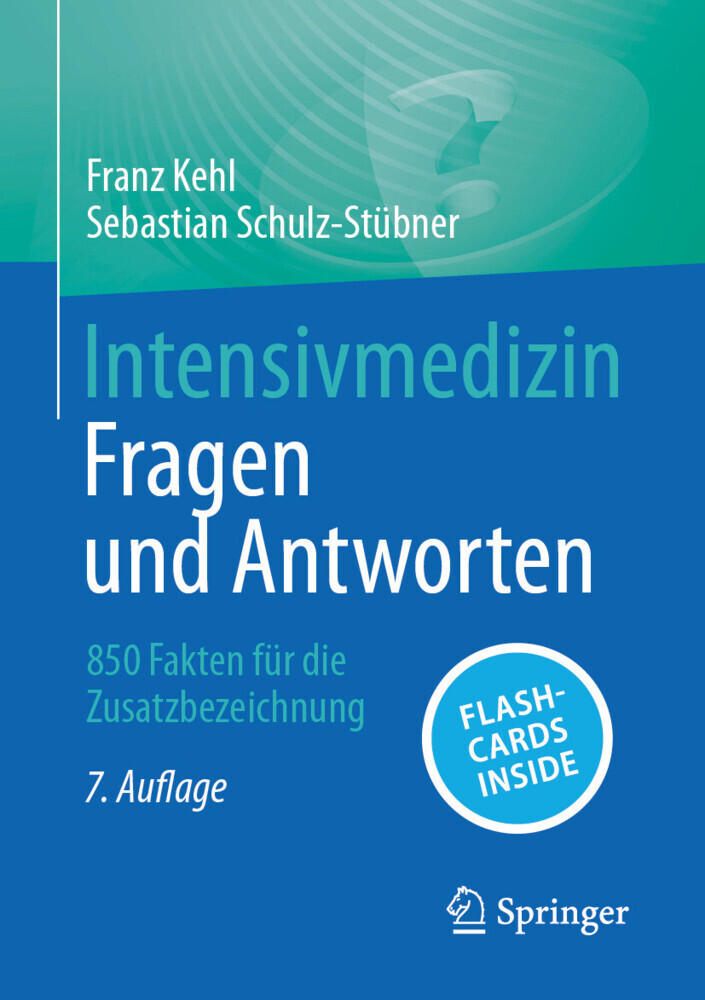Ultrasonography in Vascular Diagnosis
A Therapy-Oriented Textbook and Atlas
This edition of a well-received book that has been recommended for inclusion in any vascular library or vascular radiology suite. The first edition has been fully revised so as to provide a comprehensive, up-to-date account of vascular ultrasound that reflects recent advances. The emphasis remains on the clinical aspects most relevant to angiologists and vascular surgeons. Ultrasound anatomy is discussed, examination procedures explained, normal and pathological findings described, and the clinical impact of ultrasound assessed. Atlas sections present pertinent case material to illustrate typical ultrasound findings for both the more common vascular diseases and rarer conditions. This book will serve not only as an invaluable guide for beginners, but also as an indispensable reference for experienced sonographers, who will benefit from the detailed evaluation of the role of ultrasound as compared with other modalities and the discussion of ultrasound findings in their clinical context.
1;Ultrasonography in Vascular Diagnosis;2 1.1;Preface to the Second Englishand Third German Edition;5 1.2;Preface to the First English Edition;7 1.3;Preface to the Second German Edition;8 1.4;Preface to the First German Edition;10 1.5;Contents;12 1.6;1: Fundamental Principles;18 1.6.1;1.1 Technical Principles of Diagnostic Ultrasound;18 1.6.1.1;1.1.1 Gray-Scale Ultrasonography (B-Mode);18 1.6.1.1.1;1.1.1.1 Historical Milestones;18 1.6.1.1.2;1.1.1.2 Sound Waves;18 1.6.1.1.3;1.1.1.3 Generating Ultrasound Waves;19 1.6.1.1.4;1.1.1.4 Physical Factors Affecting the Ultrasound Scan;19 1.6.1.1.4.1;1.1.1.4.1 Reflection and Refraction;20 1.6.1.1.4.2;1.1.1.4.2 Scattering;20 1.6.1.1.4.3;1.1.1.4.3 Interference;21 1.6.1.1.4.4;1.1.1.4.4 Diffraction;21 1.6.1.1.4.5;1.1.1.4.5 Attenuation and Absorption;21 1.6.1.1.5;1.1.1.5 Generating an Ultrasound Image;21 1.6.1.1.5.1;1.1.1.5.1 Pulse-Echo Technique;21 1.6.1.1.5.2;1.1.1.5.2 Time-Gain Compensation;21 1.6.1.1.5.3;1.1.1.5.3 A-Mode;22 1.6.1.1.5.4;1.1.1.5.4 B-Mode;22 1.6.1.1.5.5;1.1.1.5.5 M-Mode;22 1.6.1.1.6;1.1.1.6 Resolution;23 1.6.1.1.7;1.1.1.7 Beam Focusing;23 1.6.1.1.8;1.1.1.8 Types of Transducers;24 1.6.1.1.8.1;1.1.1.8.1 Principle of Operation;24 1.6.1.1.8.2;1.1.1.8.2 Linear Arrays;24 1.6.1.1.8.3;1.1.1.8.3 Curved or Convex Arrays;25 1.6.1.1.8.4;1.1.1.8.4 Sector Scanners;25 1.6.1.1.8.5;1.1.1.8.5 Phased Arrays;25 1.6.1.1.8.6;1.1.1.8.6 Mechanical Sector Scanners;25 1.6.1.1.8.7;1.1.1.8.7 Annular Phased Arrays;26 1.6.1.1.8.8;1.1.1.8.8 Disadvantages of Mechanical Transducers;26 1.6.1.1.9;1.1.1.9 Ultrasound Artifacts;26 1.6.1.1.9.1;1.1.1.9.1 Posterior Shadowing;26 1.6.1.1.9.2;1.1.1.9.2 Acoustic Enhancement;26 1.6.1.1.9.3;1.1.1.9.3 Edge Effect;26 1.6.1.1.9.4;1.1.1.9.4 Side Lobes;27 1.6.1.1.9.5;1.1.1.9.5 Reverberation Artifact;27 1.6.1.1.9.6;1.1.1.9.6 Geometric Distortion;28 1.6.1.2;1.1.2 Basic Physics of Doppler Ultrasound;28 1.6.1.2.1;1.1.2.1 Continuous Wave Doppler Ultrasound;29 1.6.1.2.2;1.1.2.2 Pulsed Wave Doppler Ultrasound/Duplex Ultrasound;30 1.6.1.2.3;1.1.2.3 Frequency Processing;30 1.6.1.2.4;1.1.2.4 Blood Flow Measurement;31 1.6.1.3;1.1.3 Physical Principles of Color-Coded Duplex Ultrasound;35 1.6.1.3.1;1.1.3.1 Velocity Mode;35 1.6.1.3.2;1.1.3.2 Power (Angio) Mode;37 1.6.1.3.3;1.1.3.3 B-Flow Mode (Brightness Flow);38 1.6.1.3.4;1.1.3.4 Intravascular Ultrasound;39 1.6.1.3.5;1.1.3.5 Three-Dimensional/Four-Dimensional Ultrasound;40 1.6.1.4;1.1.4 Factors Affecting (Color) Duplex Imaging - Pitfalls;40 1.6.1.4.1;1.1.4.1 Scattering, Acoustic Shadowing;40 1.6.1.4.2;1.1.4.2 Mirror Artifact;41 1.6.1.4.3;1.1.4.3 Maximum Flow Velocity Detectable - Pulse Repetition Frequency;41 1.6.1.4.4;1.1.4.4 Minimum Flow Velocity Detectable - Wall Filter, Frame Rate;44 1.6.1.4.5;1.1.4.5 Transmit and Receive Gain;45 1.6.1.4.6;1.1.4.6 Doppler Angle;45 1.6.1.4.7;1.1.4.7 Physical Limitations of Color Duplex Ultrasound;45 1.6.1.5;1.1.5 Ultrasound Contrast Agents;47 1.6.1.6;1.1.6 Safety of Diagnostic Ultrasound;49 1.6.1.6.1;1.1.6.1 Thermal Effects;49 1.6.1.6.2;1.1.6.2 Mechanical Effects;50 1.6.1.6.3;1.1.6.3 Specific Risks of Individual Ultrasound Techniques;50 1.6.2;1.2 Hemodynamic Principles;51 1.6.2.1;1.2.1 Laminar Flow;51 1.6.2.2;1.2.2 Flow Profiles and Perfusion Regulation;53 1.6.2.2.1;1.2.2.1 Low-Resistance Flow;53 1.6.2.2.2;1.2.2.2 High-Resistance Flow;53 1.6.2.2.3;1.2.2.3 Blood Flow Regulation;54 1.6.2.3;1.2.3 Determining the Degree of Stenosis;55 1.6.3;1.3 Machine Settings;59 1.7;2: Peripheral Arteries;62 1.7.1;2.1 Pelvic and Leg Arteries;62 1.7.1.1;2.1.1 Vascular Anatomy;62 1.7.1.1.1;2.1.1.1 Pelvic Arteries;62 1.7.1.1.2;2.1.1.2 Leg Arteries;62 1.7.1.2;2.1.2 Examination Protocol and Technique;64 1.7.1.2.1;2.1.2.1 Pelvic Arteries;64 1.7.1.2.2;2.1.2.2 Leg Arteries;65 1.7.1.3;2.1.3 Specific Aspects of the Examination from the Perspective of the Angiographer and Vascular Surgeon;66 1.7.1.4;2.1.4 Interpretation and Documentation;72 1.7.1.5;2.1.5 Normal Duplex Ultrasound of Pelvic and Leg Arteries;72 1.7.1.6;2.1.6 Abnormal
Schäberle, Wilhelm
| ISBN | 9783642025099 |
|---|---|
| Artikelnummer | 9783642025099 |
| Medientyp | E-Book - PDF |
| Auflage | 2. Aufl. |
| Copyrightjahr | 2010 |
| Verlag | Springer-Verlag |
| Umfang | 520 Seiten |
| Sprache | Englisch |
| Kopierschutz | Digitales Wasserzeichen |







